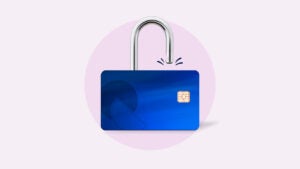What to look for in a credit card for bad credit

Key takeaways
- Secured cards might be easier for you to qualify for, as they typically require a lower credit score, though you’ll need to submit a security deposit.
- Avoid cards with annual fees if you can, and look at options with APRs around the national average as you consider your potential credit limit.
- When comparing your options, keep an eye out for perks like the potential for credit line increases and card upgrades.
Choosing a credit card when you have bad credit — a FICO score of below 670 or a VantageScore of below 661 — can feel like a dangerous move. And for good reason: Predatory products can make it extremely difficult to build credit and avoid debt.
But sometimes a credit card is still a necessary financial tool, even for those with bad credit. If you think you need one, then what should you look for and what should you avoid? Find out what factors you should keep in mind and how to choose the best card for your needs.
How to choose a credit card for bad credit
Two of the most important factors to consider are whether the card is unsecured or secured and what fees are associated with the card. It’s also important to think about the future when you’re choosing a credit card. You’ll want to find one that offers perks if possible, especially the opportunity to upgrade to a better card later on.
First, check your credit score
Before you compare your card options, it’s a good idea to check your credit score. By knowing where you stand, you gain a better understanding of your options and what to look for when choosing cards designed specifically for people who have poor credit. You might even learn that your score is actually considered a fair credit score, which can open up more credit card opportunities for you.
Weigh whether an unsecured or secured card makes sense
Next, determine whether you want an unsecured or a secured card. Unsecured cards are credit cards that don’t require a security deposit, though even the best unsecured cards for bad credit are likely to come with higher interest rates and fees, low credit limits and few or no perks.
On the other hand, secured cards require a security deposit, but they typically tend to be easier to qualify for and charge fewer fees since you’re putting down collateral. And the best secured credit cards often refund your security deposit if you demonstrate responsible spending and on-time payments.
CEO, Joe Camberato, founder of NationalBusinessCapital.com, says secured cards can be a “solid option if you’re looking to rebuild your credit.”
Understand the fees
Another important factor to consider is fees. Credit cards designed for bad credit often charge higher fees, and more of them. Depending on the card, you could find yourself facing:
- Annual fees
- Late payment fees
- Return payment fees
- Balance transfer fees
- Foreign transaction fees
- Over-the-credit-limit fees
- Cash advance fees
Read the fine print to make sure you understand each credit card fee and how much you’ll owe if you’re charged one of these fees — particularly if you’re going to carry a balance.
For example, paying an annual fee can make sense if you have no other options, but you should avoid it if you can.
Look for an interest rate that’s close to the average
Annual percentage rate (APR) for credit cards describes the yearly interest that’s charged to borrowers when they carry a balance on their card. Your credit card APR will depend on your creditworthiness, which indicates to the card issuer the amount of risk it is taking by extending your credit. The lower your credit score, the higher the APR you’re typically charged, so a higher-than-average APR can be a given for people with poor credit.
Some credit cards for poor credit charge APRs that are truly dizzying, at around 30 percent. The closer you can get to the average APR, the better.
In most cases, because of the way credit card interest works, you can avoid interest on your card purchases if you pay your bill in full each month. Most credit cards come with a grace period, yet it’s worth reading the fine print of any card to confirm that yours does too. And if there’s a chance you might carry a balance, prioritize getting the lowest interest rate you’re eligible for.
Aim for the highest credit limit
Securing a high credit limit can be tough if you have bad credit, but you want to shoot for as high as you can (as long as you won’t be tempted to overspend).
Here’s why: Your credit limit affects your credit utilization ratio, which is a significant factor in your credit score. Credit utilization is the amount you owe divided by the sum of your credit cards’ credit limits. So if you have a $200 credit limit and a $100 balance on the card, your credit utilization is 50 percent.
It’s recommended that you keep your credit utilization below 30 percent. But in general, the lower that percentage, the better your credit score.
How to find a path to better credit
When applying for a card with poor credit, it’s important to think ahead and start planning to improve your credit. Many cards for bad credit offer credit line increases after you’ve used the card responsibly for several months. An increased credit line can mean a boost to your credit score.
Also, consider the potential for a future upgrade. Most credit card issuers allow eligible customers to upgrade to a better credit card on request. Choosing a card issuer that might be able to offer an upgrade as you work to improve your credit is important.
Finally, make sure the card you’re considering reports your credit activity to all three credit bureaus. Camberato advises that the “strategy for a bad credit borrower is to leverage their initial card to improve their credit and move to a different card. To accomplish this, you’ll need to make sure that the provider reports to all three major credit bureaus.” If a lender pulls reports from TransUnion, but your credit card reports only to Equifax and Experian, that lender may not be able to see your credit activity.
The bottom line
Credit cards for people with bad credit have more pitfalls than most cards, but they can be a saving grace if you’re looking to rebuild your credit score. Camberato says, “You have to make sure that the terms of the card work for you financially. Cards for bad credit usually come with higher interest rates, lower limits and extra fees …. [but if] you use the card the right way, it can help you rebuild your credit so you can qualify for something better down the road.”
The best credit cards for bad credit come with minimal fees, a fair APR and credit-building opportunities like credit line increases and reporting to all three credit bureaus.






